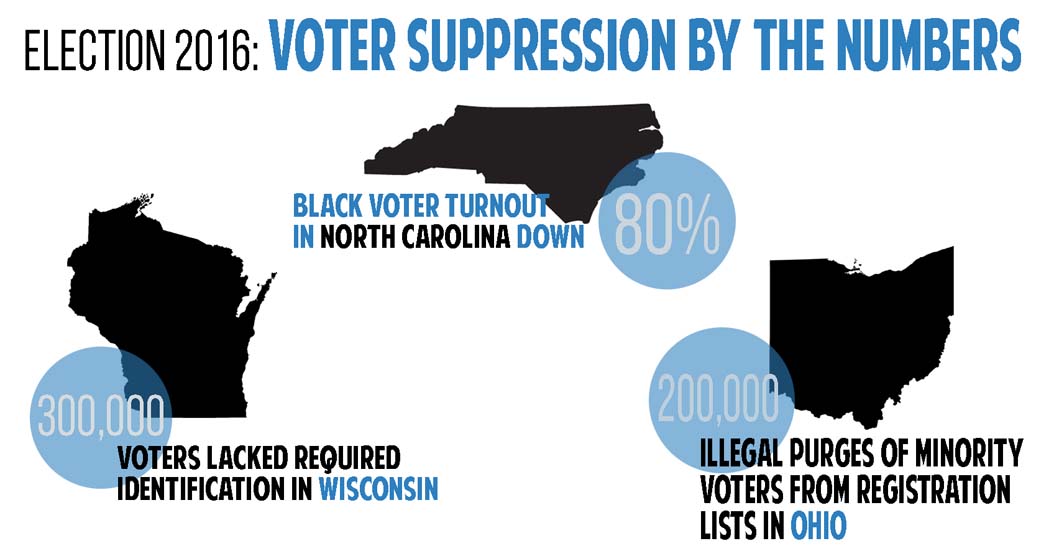Voter suppression helped decide presidential election


Jordan Mondell, Assistant Visual Editor
Try as they might, most members of the media still have very little idea what exactly happened at the polls last Tuesday.
Even pundits and pollsters as prophetic as FiveThirtyEight’s Nate Silver had consistently predicted upwards of a 70 percent chance for a Clinton victory in the general election. As we all know, that didn’t happen, and none of the most prevalent explanations give a full picture as to why.
One theory put forth by Clio Chang of the New Republic suggested that Hillary Clinton was a uniquely bad candidate who mishandled an email scandal that shouldn’t have been serious. Another hypothesis came from Trump campaign manager Kellyanne Conway, who made vague references the day after the election to voters’ desire for “change” from the broadly popular Obama administration in an interview with CNBC. And of course, appeals to the white working class as the key to Trump’s victory have been omnipresent in the media in the past week.
But there’s one narrative that’s received surprisingly little post-election attention from the media, despite the fact that it may have decided the election: voter suppression. Ahead of Election Day, media outlets expressed some concern about the topic, but the analysis has all but disappeared since Trump won the Electoral College.
Since World War II, a party has rarely won more than two presidential elections in a row, giving some credence to Conway’s “change” argument. And election day exit polls showed a yawning, nearly insurmountable 39 point advantage for Trump and Republicans among white voters without a college degree, making a similar case for the white working class theory.
There’s no denying that large GOP wins within this demographic was central to Republican victories in crucial battleground states like Wisconsin, North Carolina and here in Pennsylvania. But far more crucial to the reality TV personality’s electoral success was his party’s ability to depress Democratic turnout — he won with fewer popular votes than John McCain in 2008, Mitt Romney in 2012 and even his Democratic rival, Hillary Clinton, in 2016.
Lower turnout for Clinton might fit into the narrative that she was simply uninspiring as a candidate. But this explanation ignores the personal experiences of both the millions of voters she did inspire as well as — more importantly — minority voters. These voters, the people most likely to vote for Democrats, were effectively disenfranchised by Republican-led state legislatures and the draconian voting policies these institutions supported.
One of the worst instances of suppression was in Wisconsin, a typically blue state where the Republican ticket won by a slim margin of approximately 27,000 votes. Until 2013, the state’s voting laws were covered by the Voting Rights Act of 1965 under a provision requiring all changes in local and state voting practices to be cleared with the federal government.
Wisconsin’s Republican legislature reacted to the Supreme Court’s removal of federal oversight by requiring photo identification both to register to vote and to actually cast a ballot. State officials repeatedly appeared before a federal district judge to answer for unfairly and specifically burdening Democratic-leaning voters. Yet in the days leading up to the election, the judge complained that Wisconsin “really did nothing in response to my order” to fix the system’s gross inequalities.
Milwaukee, the heart of Wisconsin’s Democratic Party, saw a drop in turnout of about 41,000 people, attributable almost wholly to increased voting obstacles introduced under the Republican legislature and administration, according to the city’s elections chief. Across the state, estimates show nearly 300,000 voters lacked the photo identification necessary to vote under the new voting regime. We may never know how much Trump’s message actually appealed to Wisconsinites, if only because so many of them were unable to speak through the ballot box. Among those silenced were many of the state’s minority voters who planned to vote for Clinton.
While Wisconsin’s 10 electoral votes wouldn’t have been enough to change the eventual projected outcome in the Electoral College, other important states saw equally galling attempts at voter suppression. In North Carolina, the quintessential battleground state, black turnout during the early voting period declined by over 8 percent, amounting to over 60,000 fewer votes.
Here, even more so than elsewhere, the narrative of an uninspired electorate fails to explain the results. Black early voting turnout in most other Southern states saw a sharp uptick — as much as 18.5 percent in Louisiana. What was the important difference between North Carolina and similar southern states? The state’s Republican-controlled state legislature strictly cut back on both polling locations and hours for early voting.
Add to this the illegal, systematic purging of minority voters from registration lists in the state, and you have a formula for delivering North Carolina’s 15 electoral votes to the GOP. Similar purges removed over 200,000 registered voters in Ohio, while in Georgia, a Republican Secretary of State was accused of blocking thousands of minority voters from registration through an absurd system of “strict matching” of registration forms that was eight times more likely than the average to fail black applicants.
Vox writer German Lopez argued last week that voter suppression efforts alone couldn’t explain Clinton’s eventual loss in the Electoral College, in particular states like Pennsylvania where the Republican ticket won a plurality of the vote in the absence of new restrictions. But even in states like Michigan, where new identification laws weren’t in place, an uncounted number of voters were turned away at the polls with false information about voting requirements. And with both record-high interest levels among voters in general and the lowest turnout since 2000, it’s hard not to think that similarly unmeasurable disenfranchisement likely occurred across the country.
Don’t let the prevailing narratives fool you — Donald Trump’s campaign didn’t represent a broad, class-based uprising so much as the shameless, scorched-earth tactics and naked, inexorable ambition of the Republican Party’s national leadership. And whether that manifested itself in outright cheating or in subtler, psychological warfare against the American voter, it’s an unpatriotic and unconscionable blemish on our nation.
For all his bluster about a “rigged election,” the Republican candidate didn’t so much win the presidency as con his way into it. Calling Trump’s supporters the “new silent majority” is the greatest irony of all this election season — the silent majority would have drowned his followers out if they had only been allowed to speak.
Recent Posts
Review | Delayed checkouts at ‘The White Lotus’: An unoriginal third season
(Contains Spoilers) There is no meditation class, no reiki session, no nutritionally balanced, organic food…
Celebrating Women’s History Month with the HerStory Slam Event
Idaya Sasikumar, a first-year psychology student, took to the stage to read her personal story.…
Review | Michael Franti & Spearhead reflect on the power of love in new album ‘Welcome to the Family’
Nothing says “Welcome to the family!” like a new baby. Soul-rock band Michael Franti &…
How hurling put me on ESPN and in a National Championship game
Nothing is more difficult than joining a new club in college. It is terrifying when…
Column | It’s now or never for Henry Davis
When Henry Davis came into Monday night’s game against the Washington Nationals at PNC Park,…
Pitt men’s basketball navigating transfer portal difficulties
Pitt men’s basketball is like any other team in the world of large NIL deals…


